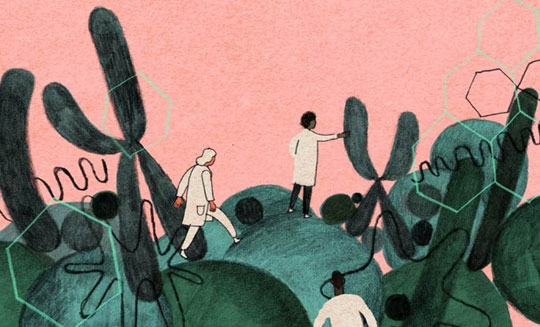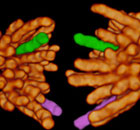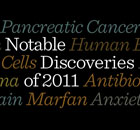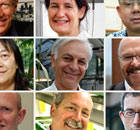
The New Pace of Genomics
It’s been more than a decade since the first draft of the human genome was sequenced. HHMI scientists, however, are still uncovering surprises in how DNA encodes all the cells in the body.
They are also developing new methods to sequence DNA, enabling studies that reveal how much the genome varies between individuals and how these variations could be linked to disease susceptibility.
In December, HHMI investigator Stephen Quake at Stanford University unveiled a technique that offers a new level of detail about a person’s genes.
All people inherit one set of genes from each parent, and traditional gene sequencing lumped both sets together. If someone had two different mutations in a single gene, it was hard to tell whether both were on a copy of the gene inherited from a single parent, or whether each parent had passed on a single mutation. Quake developed a way to separate the two strands of DNA and sequence them individually, publishing the work in Nature Biotechnology.
At the University of Pennsylvania Perelman School of Medicine, HHMI investigator Vivian G. Cheung turned her attention toward RNA—the intermediary molecule between DNA and protein production. It had long been assumed that RNA sequences closely correspond to the DNA sequences from which they are made.
Cheung, however, analyzed the RNA and DNA from 27 individuals and found, much to her surprise, that differences in these sequences occurred in about 40 percent of genes. The differences, however, were consistent among individuals, Cheung reported in the May 19, 2011, issue of Science Express. Discovering why these differences exist and how cells control them is Cheung’s next endeavor.
Researchers are also interested in the long stretches of DNA that do not code for proteins. These sections between genes, once called “junk DNA,” were thought to have little importance in the cell. HHMI early career scientist Bradley E. Bernstein and his colleagues at Massachusetts General Hospital are proving otherwise.
Bernstein mapped where certain markers of genetic regulation—called histone marks—are found in the non-protein-coding portions of human chromosomes. He found that in different cell types, these markers cluster in drastically different places. The work was published in the March 24, 2011, issue of Nature.
Histone marks influence the structure of DNA and what genes are transcribed into RNA. In particular, maps of histone marks can be used to identify regulatory sequences located far from the genes they influence. Although critical for gene regulation, such distant sequences are notoriously hard to detect, so the histone maps provide much-needed wayfinding for researchers.
Because some diseases could be caused by histones located in the wrong spots, Bernstein’s maps may also offer a starting place to compare histones in healthy and diseased cells.
Other genetic findings have more concrete and immediate links to diseases. In the February 11, 2011, issue of Science, HHMI investigator Richard P. Lifton of Yale University School of Medicine reported a genetic mutation that leads to tumors of the adrenal gland. The gene encodes a potassium channel. When it’s mutated, Lifton found, the channel lets sodium through as well as potassium. This sets off a cascade of cellular imbalances that eventually leads to tumor development and contributes to high blood pressure.
As the links between genes and diseases become clearer and new techniques make genome sequencing easier, faster, and more informative, scientists can move closer to personalized medicine. Tailoring treatments to a person’s genetic readout isn’t far off.



